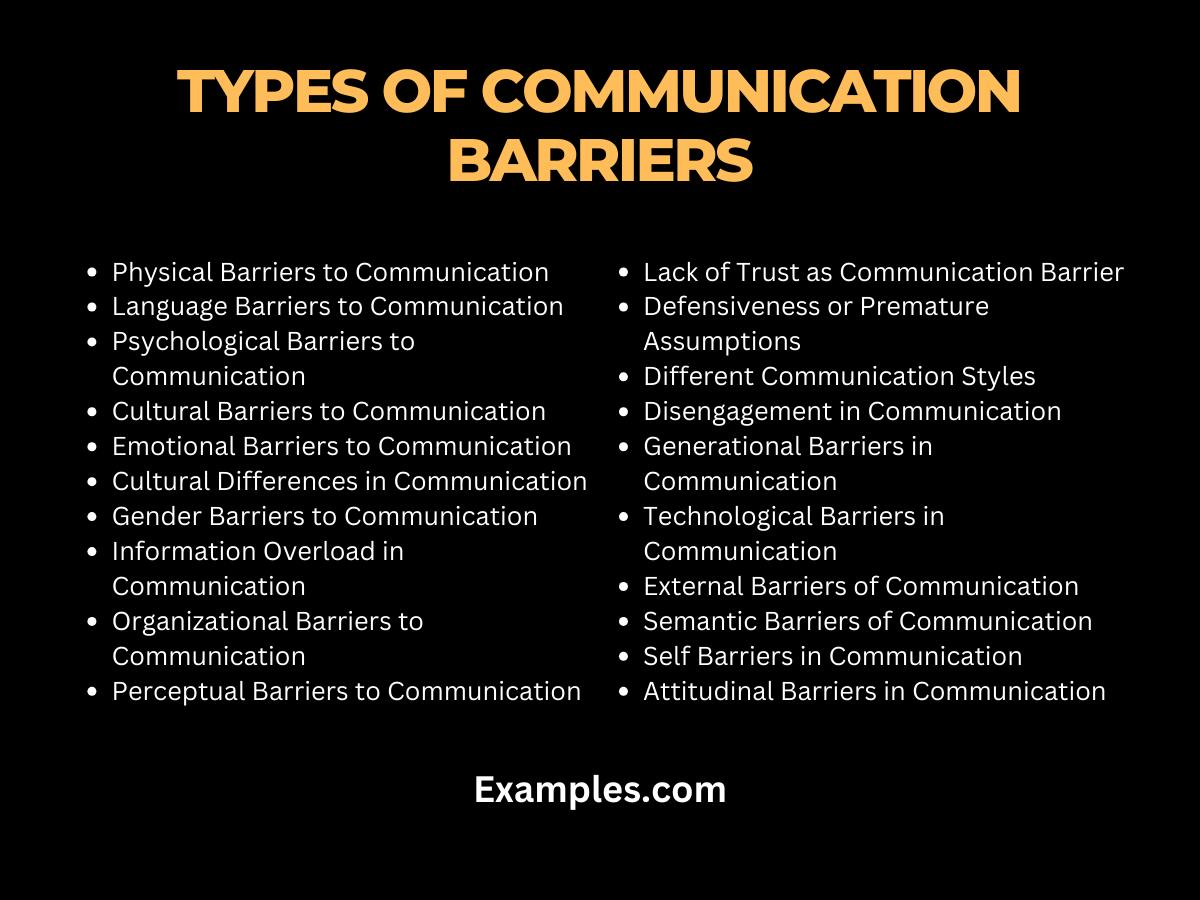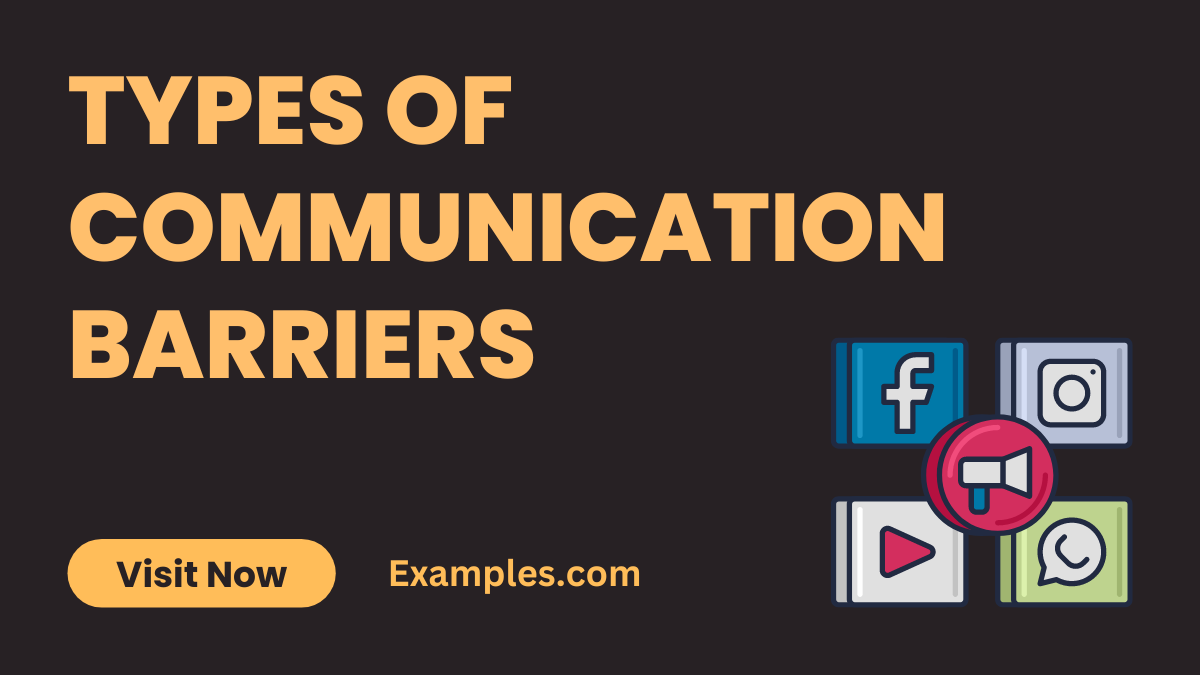19+ Types of Communication Barriers
Understanding the Types of Communication Barriers is essential in navigating and enhancing interactions in both personal and professional environments. These barriers, ranging from physical and linguistic to psychological and cultural, can significantly impede effective communication. This guide delves into various barriers, including Physical barriers, Language barriers, and Emotional barriers, providing insights on how they manifest and affect communication. It also offers strategies to overcome these obstacles, emphasizing the importance of clear and empathetic dialogue for successful communication.
20 Types of Communication Barriers List

Communication barriers can significantly hinder effective interaction in various settings. Understanding these barriers is crucial for overcoming them and improving communication. This list highlights 20 types of communication barriers, each with a specific example and explanation to illustrate how these obstacles can impact communication.
- Physical Barriers to Communication: Environmental factors like noise or distance. Physical Barriers to Communication These encompass tangible obstacles such as noise, distance, or environmental conditions that disrupt the smooth exchange of messages, requiring adjustments like relocating to quieter spaces or using alternative communication methods.
Example: “I can’t hear you well in this noisy room; let’s move somewhere quieter.” - Language Barriers to Communication: Differences in language leading to misunderstandings. Language Barriers to Communication are whether due to diverse native languages or jargon, can create misunderstandings, necessitating the use of simpler language or translation services for effective communication.
Example: “Could you please repeat that in simpler terms for better understanding?” - Psychological Barriers to Communication: Mental states like stress or anger. Psychological Barriers to Communication are Mental and emotional factors, including stress, anger, or personal issues, can hinder effective dialogue. Addressing these requires managing emotions and choosing appropriate times for discussions.
Example: “Let’s discuss this when we’re both calmer and more focused.” - Cultural Barriers to Communication: Diverse cultural norms affecting understanding. Cultural Barriers to Communication necessitating awareness and adaptability to navigate these differences effectively.
Example: “In my culture, this gesture means something different.” - Emotional Barriers to Communication: Personal feelings impacting message reception. Emotional Barriers to Communication are Recognizing and managing these emotions can promote more objective and constructive communication.
Example: “I might be taking this personally; let’s try to be objective.” - Cultural Differences in Communication: Varied communication norms across cultures. Cultural Differences in Communication require individuals to understand and adapt to different styles, whether directness or subtlety, for effective cross-cultural interactions.
Example: “Directness is valued in some cultures, while others prefer subtlety.” - Gender Barriers to Communication: Stereotypes and biases based on gender. Gender Barriers to Communication can affect conversations. Open-mindedness and avoiding assumptions can help overcome these barriers.
Example: “Let’s not let gender stereotypes influence our conversation.” - Information Overload in Communication: Too much information causing confusion. Information Overload in Communication is Breaking down information into manageable portions can enhance understanding and decision-making.
Example: “Let’s break down this information to avoid overwhelm.” - Organizational Barriers to Communication: Hierarchical structures limiting open communication. Organizational Barriers to Communication can limit open dialogue. Fostering a culture of open communication and feedback can address this barrier.
Example: “Our vertical structure makes it hard to share feedback upwards.” - Perceptual Barriers to Communication: Personal perceptions affecting interpretation. Perceptual Barriers to Communication can influence interpretation. Encouraging empathy and considering different perspectives can help overcome these barriers.
Example: “My previous experience might be affecting how I view this situation.” - Lack of Trust as Communication Barrier: Mistrust leading to withheld information. Lack of Trust as Communication Barrier are Building trust through transparent and honest communication is essential to mitigate this barrier.
Example: “Building trust will help us communicate more openly.” - Defensiveness or Premature Assumptions: Jumping to conclusions or being defensive. Defensiveness or Premature Assumptions can hinder effective dialogue. Active listening and seeking clarification can help address this barrier.
Example: “I shouldn’t assume; let me hear your side of the story.” - Different Communication Styles: Varied preferences in communication methods. Different Communication Styles, such as written or verbal, require flexibility and understanding to accommodate diverse communication styles.
Example: “I prefer emails, but I understand you like direct conversations.” - Disengagement in Communication: Lack of interest or attention. Disengagement in Communication are Lack of interest or attention during conversations can impede effective communication. Engaging actively and showing interest in discussions can help overcome this barrier.
Example: “Your engagement in this discussion will help us find a solution.” - Generational Barriers in Communication: Different preferences across age groups. Generational Barriers in Communication are Different generational preferences in communication styles, such as face-to-face or digital, may require adaptation and bridging generational gaps for effective dialogue.
Example: “As a team, we should adapt to various generational communication styles.” - Technological Barriers in Communication: Challenges due to technology use. Technological Barriers in Communication are Challenges related to technology such as unfamiliar tools or technical issues, may require training and troubleshooting to ensure smooth communication
Example: “Let’s ensure everyone is comfortable with this new communication tool.” - External Barriers of Communication: Outside factors impacting communication. External Barriers of Communication are Finding conducive environments and minimizing distractions can address this barrier.
Example: “External noise is making it difficult to concentrate on our conversation.” - Semantic Barriers of Communication: Misunderstandings due to word meanings. Semantic Barriers of Communication are interpretations may necessitate clarifications and common understanding of terminology.
Example: “To avoid confusion, let’s clarify the meaning of these terms.” - Self Barriers in Communication: Personal limitations like shyness or lack of confidence. Self Barriers in Communication can hinder self-expression. Building self-confidence and communication skills can help overcome these barriers.
Example: “Building confidence will help you communicate your ideas more effectively.” - Attitudinal Barriers in Communication: Personal attitudes affecting willingness to communicate. Attitudinal Barriers in Communication can impact willingness to communicate openly. Promoting open-mindedness and awareness of biases can mitigate these barriers.
Example: “Being open to different viewpoints can enhance our discussion.”
By identifying and understanding these various Types of Communication Barriers, individuals and organizations can develop strategies to navigate and mitigate these challenges, leading to more effective and successful communication.
Understanding the various Types of Communication Barriers is essential for fostering effective and clear communication in any setting. This guide provides insights into the diverse challenges that can impede understanding and offers practical tips for overcoming them. By recognizing and addressing these barriers, we can enhance our interactions, leading to more productive, inclusive, and successful communication in both personal and professional spheres.



